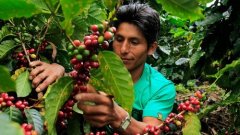Gentle and supple Costa Rican Tarazu boutique coffee beans grind degree baking degree treatment method simple

Tarazhu is very famous in the world of boutique coffee and is one of the major coffee producing areas in the world. In the 2014 COE competition, of the 23 beans on the list, 17 came from Tarasu. Tarasu is located in the fertile volcanic region of Central America, which has a humid climate and fertile volcanic soil, abundant rainfall throughout the year, high altitude, and dense forest natural shade, providing a unique growth environment for coffee growth. Pesticides or artificial fertilizers are not used in the planting process. Nearly 95% of the coffee beans produced in Tarazhu Alpine are very hard beans (SHB), which generally grow above 1500 meters above sea level.
At present, the Tarazhu Cooperative has 26 member estates. Among them, Raminita Manor, which is one of the most famous coffee farms in Tarazu. La Minita produces about 1 million pounds of coffee beans a year, and after the entire estate produces coffee beans that are carefully selected to remove defects, only 15 per cent of the coffee beans can bear the mark of the Laminita estate, while the rest enter the coffee market. But the prices of these coffees entering the market are still higher than those of other beans produced in Central America. Raminita's strict management of all aspects of coffee production has established a world-class reputation and can be called a world-renowned coffee farm.
The flavor of Costa Rica has always been steady, without the sharpness of Guatemala, it is quite mild and supple, sour, sweet and bitter chocolate, inclusive and well-balanced, is the classic flavor of gourmet coffee. The seven major coffee producing areas are as follows: Durieba Valley (northeast of the capital San Jose), Central Valley (northwest of San Jose), Western Valley (west of the capital), Sanhe District (east side of the capital), Blanca (southeast of the capital), Orosi (north of the capital), Tarazu (south of the capital). Among them, the Central Valley, Tarazhu and Sanhe producing areas are the most famous. In principle, the quality of coffee sloping towards the Pacific is better than that facing the Atlantic. In the 2007 Costa Rica Cup Test Competition, the champion farm Serobado was located in the Tarazu producing area south of San Jose, but the Central Valley also performed well, with two to four from the city of Naranhe. Sanhe District seems to have been left out.
Red honey treatment is a unique processing method of coffee. After picking, the coffee fruit is like a red cherry-shaped fruit. The coffee bean is the coffee core, wrapped by the peel, pulp and inner fruit membrane of the coffee fruit. Mature coffee fruits should be treated immediately after picking to avoid corruption. The raw bean treatment of coffee is the process of removing the exocarp and pulp of coffee, and then taking out the seeds through fermentation. Generally, there are four common treatment methods on the market: sun treatment, water washing treatment, semi-washing treatment and honey treatment.
And this coffee bean treated with red honey gives full play to the sweetness of coffee. The fragrance of apple and carambola in the front is very rich, and the taste of cream chocolate in the back is also eye-catching. This is a fine coffee worth tasting. Red honey treatment is a unique processing method of coffee. After picking, the coffee fruit is like a red cherry-shaped fruit, and the coffee bean is the coffee core. Wrapped by the pericarp, pulp and endocarp of the coffee fruit, the ripe coffee fruit should be treated immediately after picking to avoid spoilage. The raw bean treatment of coffee is the process of removing the exocarp and pulp of the coffee and then fermenting the seeds. Generally, there are four common treatment methods on the market: sun treatment, water washing treatment, semi-washing treatment and honey treatment.
And this coffee bean treated with red honey gives full play to the sweetness of the coffee. The aroma of apple and carambola in the first section is very rich, and the taste of cream chocolate in the latter section is also eye-catching. This is a fine coffee worth tasting. The coffee beans of Shenhua Manor are handled by Costa Rica's well-known Tang Meo processing plant. It is good at improving the quality of coffee and retaining its uniqueness. In other words, the different flavors caused by altitude, soil, rainfall, temperature, temperature and other microclimate are aimed at planting, harvesting, post-processing and exporting high-quality coffee in harmony with the environment. Shenhua Manor uses very strict standards to control the growing environment and processing process of coffee, which is very strict! Maria Auxiliadora Bonilla, the daughter of the farm operator, is a barista and a Costa Rican WBC champion in 2013. they have a professional coffee cup testing laboratory, and each batch of raw beans goes through the cup test to confirm that the flavor is impeccable.
Red honey treatment is a unique processing method of coffee. After picking, the coffee fruit is like a red cherry-shaped fruit. The coffee bean is the coffee core, wrapped by the peel, pulp and inner fruit membrane of the coffee fruit. Mature coffee fruits should be treated immediately after picking to avoid corruption. The raw bean treatment of coffee is the process of removing the exocarp and pulp of coffee, and then taking out the seeds through fermentation. Generally, there are four common treatment methods on the market: sun treatment, water washing treatment, semi-washing treatment and honey treatment.
And this coffee bean treated with red honey gives full play to the sweetness of the coffee. The fragrance of apple and carambola in the former section is very rich, and the taste of cream chocolate in the latter section is also eye-catching. This is a fine coffee worth tasting.
There are many excellent producing areas in Costa Rica, and the high-quality producing areas of Costa Rica have a common understanding of quality, that is, it requires the use of mature coffee fruits to ensure the production of high-quality coffee.
Generally speaking, a large amount of water is used in the post-processing of the picked coffee fruit, but the advanced production equipment in Costa Rica saves the use of water resources to the greatest extent, and a circulating filter is used to treat the waste water from washing coffee beans. let the waste water be purified into clean water to prevent pollution of the local soil environment.
After peeling, the peel and pulp of the coffee fruit are recovered as feed for livestock, or converted into organic fertilizer, as well as coffee bean dryer fuel. It can be said that in every process of coffee production, Costa Rica complies with the requirements of maintaining the natural environment.
Among the many excellent producing areas in Costa Rica, there is a famous producing area-Tarazu (Tarrazu), also known as Tarasu.
Important Notice :
前街咖啡 FrontStreet Coffee has moved to new addredd:
FrontStreet Coffee Address: 315,Donghua East Road,GuangZhou
Tel:020 38364473
- Prev

The clear flavor of Costa Rica Tarazhu boutique coffee beans cultivation geographical location climate elevation
S.H.B. It is a very hard bean with an altitude of more than 1500 meters above sea level, which means high quality Costa Rican coffee. This extra-hard coffee bean suitable for medium and heavy roasting has a strong sour taste and charming aroma. Costa Rican SHG coffee is usually full-grained, the flavor is clear, the acidity is bright and the consistency is ideal. The strong flavor makes the tail rhyme reverberate in the throat for a long time.
- Next

Guatemala Antigua Flower Flower Flavor Coffee Flavor description Jane
The Antigua Valley (Antigua Valley) is the oldest and best-known coffee producing area in Guatemala. Volcanoes and extremely shallow groundwater levels form a dry microclimate, characterized by low humidity, adequate sunshine and cool nights. Antigua is a closed valley surrounded by three volcanoes: Agua, Acatenango and
Related
- Detailed explanation of Jadeite planting Land in Panamanian Jadeite Manor introduction to the grading system of Jadeite competitive bidding, Red bid, Green bid and Rose Summer
- Story of Coffee planting in Brenka region of Costa Rica Stonehenge Manor anaerobic heavy honey treatment of flavor mouth
- What's on the barrel of Blue Mountain Coffee beans?
- Can American coffee also pull flowers? How to use hot American style to pull out a good-looking pattern?
- Can you make a cold extract with coffee beans? What is the right proportion for cold-extracted coffee formula?
- Indonesian PWN Gold Mandrine Coffee Origin Features Flavor How to Chong? Mandolin coffee is American.
- A brief introduction to the flavor characteristics of Brazilian yellow bourbon coffee beans
- What is the effect of different water quality on the flavor of cold-extracted coffee? What kind of water is best for brewing coffee?
- Why do you think of Rose Summer whenever you mention Panamanian coffee?
- Introduction to the characteristics of authentic blue mountain coffee bean producing areas? What is the CIB Coffee Authority in Jamaica?

